Feeling frustrated by your dog’s incessant barking? Vocalizing is a natural canine behavior, and it’s normal for your pup to express himself at times. But sometimes you just need him to zip it.
Don’t worry – you can learn how to get your chatty doggo to pipe down by teaching him a “quiet” cue. We’ll explain how to do so below!
In this article, we’ll be using the word “command” because it’s commonly used by dog owners. However, “command” is a loaded word. It has a “do this, or else” vibe, with an expectation of robotic obedience. We prefer the word “cue,” which is a signal for the dog to do a particular behavior which has been taught using positive reinforcement.
The Importance of Teaching Your Dog a “Quiet” Command

It can be very useful to have a way to ask your dog to be quiet if his barking carries on for too long. Here are a few benefits of training a “quiet” cue:
- Easily interrupt barking: Wouldn’t it be nice if you could stop the barking with a simple word? No relationship-damaging yelling or threats are required.
- Prevent barking from becoming a habit: The behaviors your dog repeats turn into habits. The more he barks, the more he will continue to do so. By quieting him down, you can keep over-the-top barking from becoming his go-to behavior.
- Reduce household stress: Nonstop barking can really raise your blood pressure. If you have other pets, the noise may also be worrying to them. You might even be worried about disturbing your neighbors. A “quiet” cue can reduce everyone’s stress levels.
- Improve your relationship with your dog: You may find that your dog’s excessive barking makes you feel sour toward him. All the noise might put a strain on your relationship. Having a way to quiet him can reduce negative feelings triggered by his barking.
Tools & Supplies for Teaching Your Dog to Stop Barking

You don’t need a ton of tools to teach a “quiet” cue, but you will need a few basic items. So, gather up these supplies to make sure you’re fully prepared to work through the training process.
- High-Value treats: You’ll need something very yummy and more interesting than his usual kibble or treats. And think small too – pick treats that are about the size of a pea.
- Treat jars or treat pouches: Keep treats readily available by putting them in jars placed in accessible locations, or get used to wearing a treat pouch on your nearly 24/7.
- Snuffle mat (optional): While it’s not completely necessary, you might find that a snuffle mat aids in the training process. The snuffle mat gets your pup sniffing and foraging, which helps calm him down — something that’s very useful for barky canines!
How to Teach Your Dog a “Quiet” Command: Step-by-Step Instructions

Once you’ve got all your supplies on hand, it’s time to begin training! This method is inspired by trainer Kiki Yablon’s “Thanks for Barking” approach but with our own twist.
Step 1: Set the Stage for Silence
Fill your treat jars and place them in cabinets or on shelving or furniture that is easily accessible to you, but out of reach of your dog. Put the jars in areas of your home that you and your dog tend to spend a lot of time in.
If you’re using a snuffle mat, you can place it on the floor near the jar.
Step 2: Choose a New Cue
While you might already have a word or phrase you use to attempt to quiet your barking dog, it’s best to start this training process with a brand new one.
It might be tempting to yell something like “No!” or “Shut up!” when he’s carrying on, but your new cue should be something you can say in a calm, but clear tone of voice.
Here are a few ideas to consider for a new cue:
- “Quiet”
- “All done”
- “Zip it”
- “Enough”
- “Hush”
Step 3: Condition the Cue
In this step, you will introduce the new cue to your dog.
Dogs don’t inherently understand what human words mean, so just saying the cue won’t accomplish anything.
This is where conditioning comes into play.
Conditioning happens when a neutral stimulus, such as “quiet,” is paired with a positive stimulus, such as delicious treats. By pairing the cue with treats, your dog will form a positive association with the word.
Our first step is to work on building this positive association between the “quiet” cue and the tasty treats — we’re not even going to bring barking into the equation yet.
- Stand next to a treat jar. Your hands should be empty and in a neutral position, such as at your sides or behind your back, rather than reaching for the treats. If you’re using a snuffle mat, have it near your feet. Do not give him the treats directly from your hand or toss them to him.
- Call your dog over to you so that he’s right in front of you, if he isn’t already by you already.
- Say your new cue, such as “quiet” in a calm, clear voice. There’s no need to use a stern, scary, or threatening tone.
- Grab a small handful of treats and scatter them on the ground or the snuffle mat, bed, or rug. Make sure you’ve finished saying the word or phrase before you reach for the treats, as the goal is for the cue to precede the appearance of treats.
- Wait for your pup to finish finding and eating all the treats and then repeat these steps 5 to 10 times per session. Do this two or three times a day.
Work on this training step in low distraction spaces inside your home, where it is unlikely that your dog will bark. Practice in the various locations where you’ve placed jars and at different times of day.
At this stage, your new cue is not yet ready to function as a “quiet” signal and so you DON’T want to be utilizing it when your dog is barking. (Don’t worry, that step is coming!)
Step 4: Add Some Distance

In the last step, your pup was right in front of you as you conditioned the “quiet” cue. Now it’s time to gradually add in some space between you and him. This makes the training more like real life, as oftentimes, he is across the room or even out of your sight when barking.
- Use the “quiet” cue from a few feet away from the treats. When you’re a few feet away from a treat jar, and your dog is minding his own business, say “quiet.”
- As soon as you’ve finished saying the cue, move toward the jar, grab a handful, and scatter it on the ground or mat. Even if your dog didn’t look at you, get up, or follow you to the jar, you should still scatter the treats.
- Continue practicing this at random times of day, and in different locations, until you see your dog perk up and follow you over to a nearby jar as soon as he hears “quiet.”
- Add in more distance – both distance from the jar, and distance between you and your dog — while practicing these same steps.
You can practice this two to five times a day. It’s best to do these as one-offs, rather than back-to-back repetitions. So after the first “quiet,” wait a while so your dog isn’t thinking about the treats until you practice another.
When your loudmouth is readily responding to the “quiet” cue by following you over to a treat jar and enjoying a scatter, even with distance, you can move to step 5.
Step 5: Add Distractions
Before we use “quiet” as a way to interrupt barking, it’s helpful to add in some distractions to the training. This strengthens the cue so that it will work even when your dog is barking.
Make a list of distractions you can use to test your “quiet” cue. These should all be things that will normally grab your four-footer’s attention. Your dog’s distraction list will be unique to him, but here are some ideas to get you thinking:
- A family member talking to or petting the dog
- A family member eating a snack
- A tossed toy
- Looking out the window (but not barking)
- Standing by the door (but not barking)
When your dog is distracted, say “quiet” and then scatter some treats on the ground. Ideally, he should leave the distraction and follow you over to the jar. If he doesn’t, choose an easier distraction, then work back up to the distraction that was tough for him to leave.
Once your dog can disengage from some distractions around the house when he hears the “quiet” cue, you can proceed to step 6.
Step 6: Use the Cue to Interrupt Barking
It’s time to use your new cue as a way to stop the barking!
While the previous steps may have seemed completely unrelated to quieting your barking dog, you now have a solid response to “quiet” that you can insert into barky situations.
- As soon as your dog starts to bark, say “quiet.” Initially, it can help to be close to your dog when you give the cue (if you’re upstairs or in another room when you give the cue, it may be hard for your pup to respond). Then, head to the nearest jar and give him a treat scatter.
- When “quiet” is successfully interrupting his barking when you’re nearby, you can start to give the cue when you’re further away. Keeping jars in convenient locations in your home makes it easy to reward him for quieting down.
At this point, all your training is paying off! Your new cue now acts as an effective interrupter to your dog’s barking, giving you more peace and quiet.
Tips for an Effective Dog “Quiet” Command
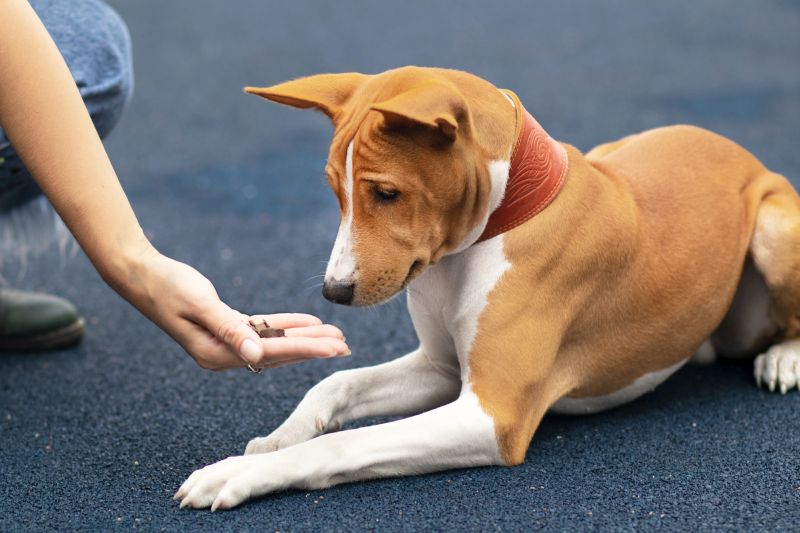
Now that you know the basics of teaching your dog a “quiet” command, try to incorporate some of these tips and tricks:
- Give the “quiet” cue early. Rather than waiting until the barking has you at your wit’s end to say “quiet,” try to give it at the first indication of vocalization. That might be when he trots over to the window to yell at a squirrel, or the first bark when he hears the neighbor come home. He’s more likely to respond with an early intervention.
- Keep rewarding while he’s quiet. If the trigger that normally causes your dog to park is still present (like another dog walking by, or a truck backing up sound), continue to reward your dog for ongoing silence. Every few seconds, throw down some treats. You can extend the time between treats over time, and may eventually be able to reinforce the “quiet” cue with just a single treat. But, especially at first, the cue will need to be heavily maintained through ongoing rewards and reinforcement!
- Place the treat jars strategically. If your pup is likely to bark at a certain window or door, place a jar at a distance away from that spot. This will encourage him to come away, which will help him calm down.
- Manage the environment to decrease barking. Good training always includes management, which means changing the environment to make unwanted behavior less likely. You’ll find lots of easy management ideas later in this article, so keep reading. Management will reduce the number of times you need to use your “quiet” cue.
- Triggers become a signal to seek you out instead of barking. With consistent practice, your dog may start to come find you when he notices a trigger, rather than vocalizing. Make sure you reward these smart choices with treats — don’t just ignore your dog’s good behavior, reward it!
- Ensure your dog is getting sufficient exercise. Sometimes excessive barking happens because a dog has excess energy, whether physical or mental. When a dog has unmet needs, training is not as effective, no matter how good it is.
- Consider a vet check. If your dog’s sudden barking bonanzas are a drastic change from your dog’s normal quiet demeanor, definitely consider visiting your vet. Pain or discomfort can result in a desperate who barks non-stop because he’s so uncomfortable.
Common Mistakes When Training “Quiet”
A few of the most common mistakes owners make when trying to train a dog to be quiet include:
- Rushing through the beginning steps. Those first few steps can seem tedious, but if you gloss over them, the “quiet” cue will not easily cut through your dog’s barking.
- Not using high-value treats. The treats you use for this training need to be worth your dog’s while, especially if excessive barking has been a long-running issue. Don’t be stingy!
- Trying to train “quiet” when your dog is barking. Other training methods have you wait until your dog stops barking, and then reward the quiet. We find that it’s much more effective to teach a “quiet” cue away from situations that trigger barking, and then insert it into barky contexts.
- Teaching your dog “speak” as a way to teach “quiet.” You may have also heard that you should teach your dog to bark on cue, as a way to teach him to hush up. Encouraging your dog to bark usually results in even more vocalization, which is the opposite of what you’re after. Don’t waste your time training him to “speak.”
- Worrying too much about accidentally rewarding the bark. Some owners become hyper concerned about accidentally throwing down treats right as their dog begins barking. If you throw down treats at the wrong time, won’t it reinforce barking? Well — it certainly can happen that way, but it’s not incredibly likely. When you scatter a handful of treats for your dog to go find, you become much more interesting than the trigger, and the dog will stop barking. If you keep throwing down kibble, your dog will continue to stay silent — and that’s working towards the learning we want!
Hey there, dog moms and dads! Meg here.
When I was first taught how to establish a “quiet” cue with my own dog Remy, he barked so darn much that we didn’t really have a choice but to throw kibble while he was still barking. Remy is very food motivated, and after saying “quiet” and throwing down treats a few times in a row (even when he was initially barking), he began to stop barking and look to me instead for treats. Since he was more focused on me and the treats rather than the trigger, he naturally stopped barking, allowing me to further reinforce the “quiet” cue with silence.
While I can’t say someone with a less food-obsessed dog would have a similar experience, I will say for me and my super food-motivated guy, scattering treats mid-bark did not result in any increased barking and worked just fine for us!
It’s Essential to Know Why Your Dog is Barking
In order to really make your “quiet” command effective, it’s essential to understand why your dog is barking in the first place.
Dogs do not simply bark for no reason. There is always a reason, and understanding why your dog is barking will allow you to address the problem.
A “quiet” cue works best for barking that’s directed at sights or sounds. It’s just the thing for a dog who barks at triggers (such as squirrels, strangers, or trucks) that he sees outside.
If your dog’s barking stems from unmet needs, boredom, or attention seeking, a different approach is likely needed.
If it feels like your dog barks at everything and anything, there may be some other underlying issues at play. Ask youself:
- Is my dog getting enough mental enrichment, like puzzle activities?
- Is my dog getting outside enough for walks and other activities?
- Could my dog be in physical discomfort?
- Has something changed recently in the home or our daily routine that could be stressing out my dog?
- Is my dog barking at people or strangers?
- Is the vocalizing only happening during a certain time of day, such as barking at night or first thing in the morning?
Dogs Who Bark from Fear May Require Additional Help
If you recognize your dog is barking at people, objects, or situations that are scaring him, a “quiet” cue may not be enough, as you need to help your dog be less afraid of these triggers in order to truly help him.
The “quiet” cue won’t necessarily hurt; since you’re using food alongside your “quiet” command, the food will already be helping your dog establish a positive association with the trigger.
But, you’ll also likely want to work on a more in-depth desensitization and counter-conditioning plan for these certain fear-inducing triggers.
If you’re unsure about what type of barking your dog is doing, consult with a professional trainer or dog behaviorist.
Are Bark Collars a Good Way to Stop a Dog’s Barking?
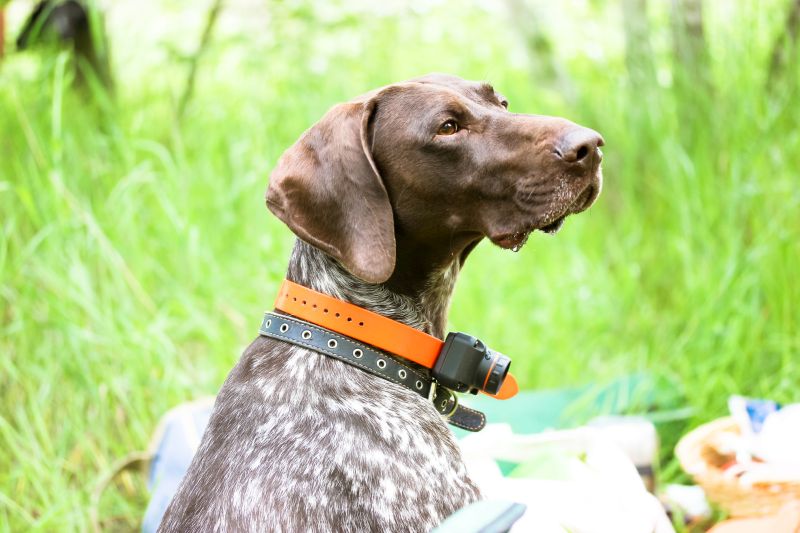
Excessive barking can become a major issue. Not only can it be extremely disruptive and stressful for you, but it can also cause trouble with your neighbors.
A bark collar can seem like a quick fix to stop your pup’s vocalization. However, bark collars aren’t as simple as they might seem.

Bark collars, such as shock and citronella collars, utilize aversive stimuli to punish barking.
An aversive is an unpleasant occurrence that happens immediately after a behavior to reduce the likelihood of that behavior happening again. The shock or blast of citronella spray from a bark collar acts as an aversive consequence.
Generally, we eschew aversive tools and methods because of the negative impact they can have on a dog. It’s possible to address barking in ways that are much more humane and ethical.
In fact, for some dogs, a bark collar may be detrimental to their wellbeing. It might cause hiding, shaking, refusal of food or playtime, or avoiding going outside to potty.
While the barking may have diminished and he gets to stay in his current home, the dog’s quality of life is lousy.
If you’re at your wit’s end with your woofer’s woofing or in a position where barking has jeopardized your living situation, consult with a dog behaviorist to help you make the best decision.
How to Distinguish Nuisance Barking from Acceptable Barking
You might wonder how to know if your dog’s barking is excessive or not? Barking is a normal dog behavior, but at what point does it become too much?
Here are some factors to consider:
- Frequency. It’s impossible to give a specific number at which point barking becomes a nuisance. However, if the frequency is more than a few times a day, then it may be deemed excessive. Just remember that some barking is completely normal — no dog should be expected to stay silent 24/7.
- Number of Triggers. Does your dog seem to bark at every little sound inside or outside of your home? Does the sight of any person, dog, critter, blowing leaf, or speck of dust set him off? Then it may be over the top. But, make sure you’re being fair to your dog’s perspective. Seeing a strange person carry a giant package up to your house is a pretty reasonable cause for a bit of barking.
- Duration. It’s normal for dogs to bark a few times and then fizzle out. If your pup’s barking seems to go on and on, and he struggles to calm down, you may be dealing with excessive levels.
It’s important to remember that the act of barking is a very normal, natural, and neutral behavior for dogs.
As humans we have the habit of deeming very natural dog behaviors as “good” or “bad”. Jumping up on people, pulling, and barking is deemed “bad” according to humans because it can inconvenience us.
But, these are all completely neutral behaviors. They are only a problem if the bother you or put others in physical danger.
And in fact, many dogs throughout history were encouraged to vocalize more. This made them better watch dogs — our dogs’ yapping was for human’s security (so it’s a bit unfair that we take such issue with it today).
So, if your dog has an inclination towards yapping, ask yourself if you really care or not.
If it’s causing your household stress and it’s a problem, by all means work on it. But if your dog is a bit of a loud-mouth and it doesn’t bother you, then just let him bark!
Breeds Prone to Excessive Barking

Some breeds of dog are barkier than others. Behavior, such as barking, is heavily influenced by genetics. Throughout history, humans selectively bred dogs to fulfill certain tasks, one of which was barking.
This served as an alarm system, which was useful for hunting and alerting their people to potential threats. Some herding breeds are also known for being loud, as barking helps them move livestock.
Today, most dogs are pets and are not used to serve their historical purpose, but the genetic predisposition for barking remains.
Here are some of the barkiest dog breeds:
- Australian Shepherd
- Beagles
- Bluetick Coonhound
- Border Collie
- Cairn Terrier
- Chihuahua
- Collie
- Corgi
- Dachshund
- Finnish Lapphund
- Fox Terrier
- German Shepherd
- Great Pyrenees
- Icelandic Sheepdog
- Mudi
- Miniature Pinscher
- Miniature Schnauzer
- Norfolk Terrier
- Norwich Terrier
- Pomeranian
- Poodle
- Pyrenean Shepherd
- Samoyed
- Scottish Terrier
- Shetland Sheepdog
- West Highland White Terrier
- Yorkshire Terrier
Other Ways to Encourage Quiet Behavior in Your Dog

While you work on training a “quiet” cue, it’s also important to set up your home space to decrease the likelihood of barking.
Here are some simple ways you can manage the environment to encourage more quiet behavior.
- Apply window film. This is a cheap, quick way to block your dog’s view out of windows, while still letting in light. Window cling can be cut to any window size. It takes only a couple of minutes to put up, and you can remove it in seconds.
- Draw the blinds. Similar to window film, closing your blinds or drapes can prevent a dog from barking at things he sees outside. While some dogs will find a way to get around the covering (in which case we’d recommend checking out dog-proof blinds), it’s worth a try.
- Set up gates. If your dog tends to bark in certain areas of your home, you can use gates or a stretched-out exercise pen to keep him from accessing his favorite barking spots.
- Play white noise. A white noise machine can help drown out sounds that might trigger your dog’s barking.
Teaching your dog a “quiet” command is a useful tool to calm a barky dog.
It can bring some much needed peace into your home, reducing the stress levels of anyone within earshot of your lovable loudmouth.
Remember that “quiet” is just one piece of solving the excessive barking puzzle. Consistently meeting your dog’s exercise and attention needs, as well as managing the environment to prevent barking, are just as important.
Have you taught your dog a “quiet” command? What triggers your pup to bark excessively?
Share your experiences and any questions in the comments below!


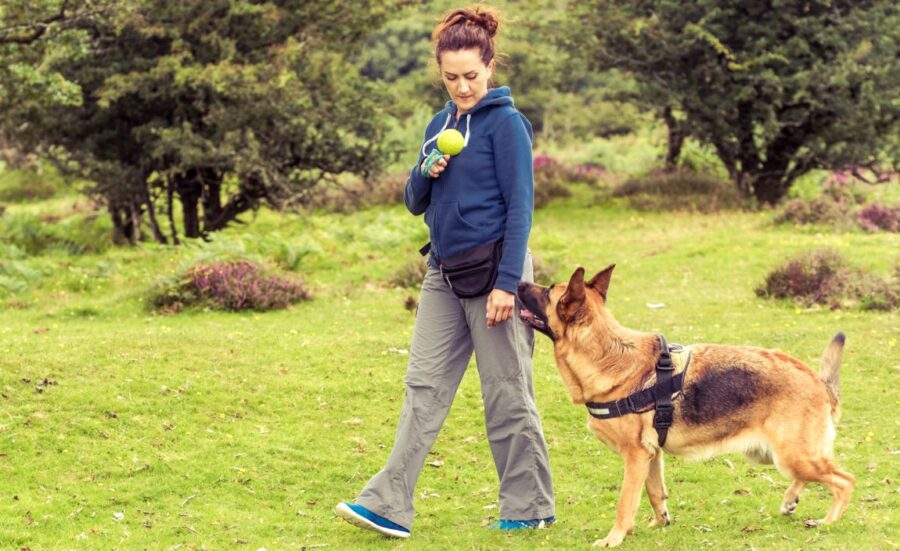



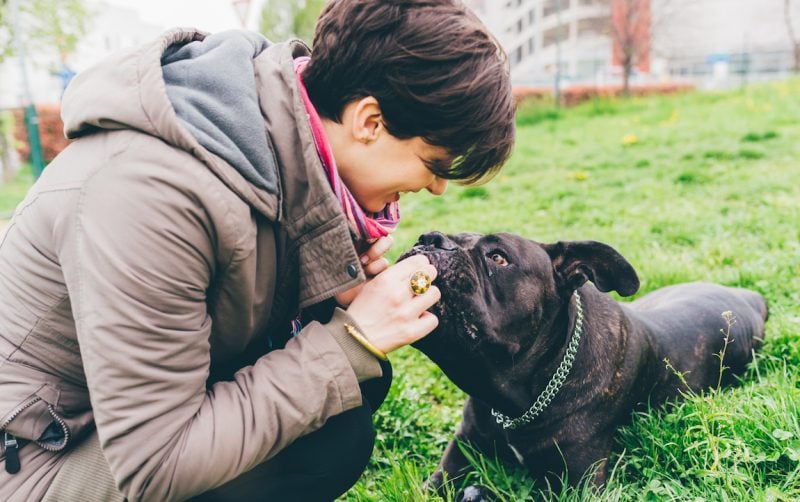
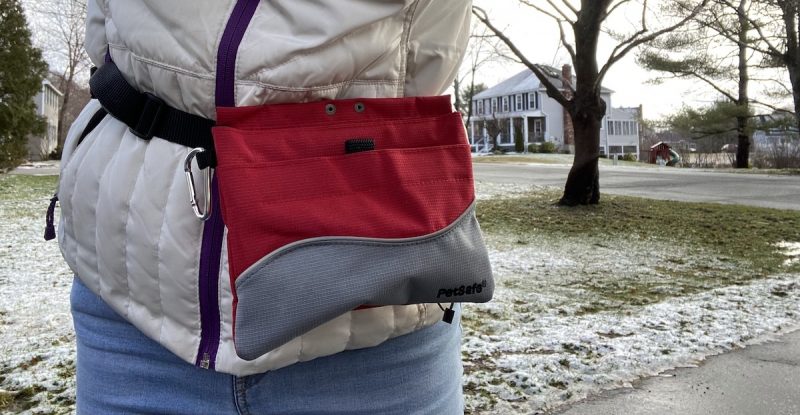



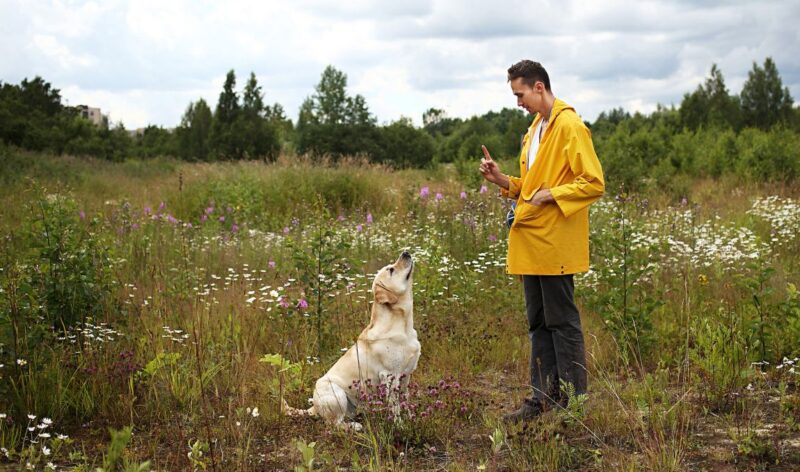

Leave a Comment